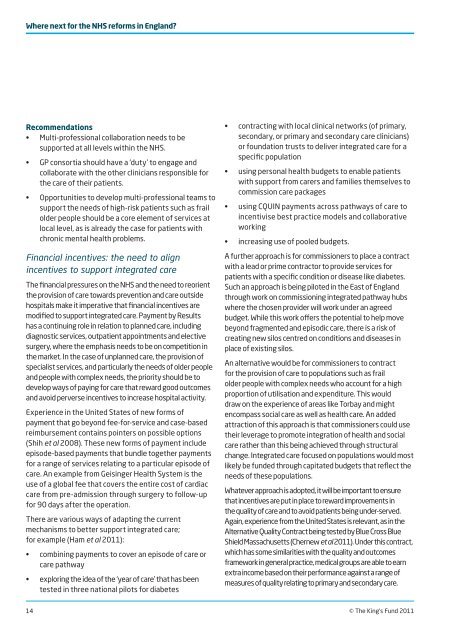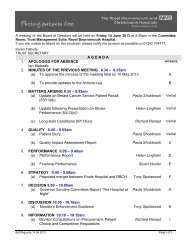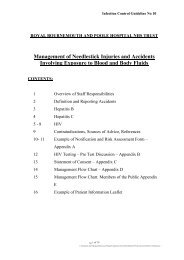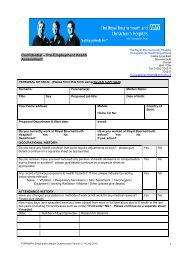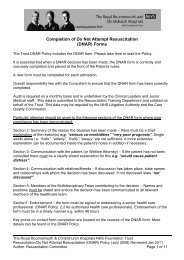View June's Board Pack - Royal Bournemouth Hospital
View June's Board Pack - Royal Bournemouth Hospital
View June's Board Pack - Royal Bournemouth Hospital
- No tags were found...
Create successful ePaper yourself
Turn your PDF publications into a flip-book with our unique Google optimized e-Paper software.
Where next for the NHS reforms in England?Recommendations• Multi-professional collaboration needs to besupported at all levels within the NHS.• GP consortia should have a ‘duty’ to engage andcollaborate with the other clinicians responsible forthe care of their patients.• Opportunities to develop multi-professional teams tosupport the needs of high-risk patients such as frailolder people should be a core element of services atlocal level, as is already the case for patients withchronic mental health problems.Financial incentives: the need to alignincentives to support integrated careThe financial pressures on the NHS and the need to reorientthe provision of care towards prevention and care outsidehospitals make it imperative that financial incentives aremodified to support integrated care. Payment by Resultshas a continuing role in relation to planned care, includingdiagnostic services, outpatient appointments and electivesurgery, where the emphasis needs to be on competition inthe market. In the case of unplanned care, the provision ofspecialist services, and particularly the needs of older peopleand people with complex needs, the priority should be todevelop ways of paying for care that reward good outcomesand avoid perverse incentives to increase hospital activity.Experience in the United States of new forms ofpayment that go beyond fee-for-service and case-basedreimbursement contains pointers on possible options(Shih et al 2008). These new forms of payment includeepisode-based payments that bundle together paymentsfor a range of services relating to a particular episode ofcare. An example from Geisinger Health System is theuse of a global fee that covers the entire cost of cardiaccare from pre-admission through surgery to follow-upfor 90 days after the operation.There are various ways of adapting the currentmechanisms to better support integrated care;for example (Ham et al 2011):• combining payments to cover an episode of care orcare pathway• exploring the idea of the ‘year of care’ that has beentested in three national pilots for diabetes• contracting with local clinical networks (of primary,secondary, or primary and secondary care clinicians)or foundation trusts to deliver integrated care for aspecific population• using personal health budgets to enable patientswith support from carers and families themselves tocommission care packages• using CQUIN payments across pathways of care toincentivise best practice models and collaborativeworking• increasing use of pooled budgets.A further approach is for commissioners to place a contractwith a lead or prime contractor to provide services forpatients with a specific condition or disease like diabetes.Such an approach is being piloted in the East of Englandthrough work on commissioning integrated pathway hubswhere the chosen provider will work under an agreedbudget. While this work offers the potential to help movebeyond fragmented and episodic care, there is a risk ofcreating new silos centred on conditions and diseases inplace of existing silos.An alternative would be for commissioners to contractfor the provision of care to populations such as frailolder people with complex needs who account for a highproportion of utilisation and expenditure. This woulddraw on the experience of areas like Torbay and mightencompass social care as well as health care. An addedattraction of this approach is that commissioners could usetheir leverage to promote integration of health and socialcare rather than this being achieved through structuralchange. Integrated care focused on populations would mostlikely be funded through capitated budgets that reflect theneeds of these populations.Whatever approach is adopted, it will be important to ensurethat incentives are put in place to reward improvements inthe quality of care and to avoid patients being under-served.Again, experience from the United States is relevant, as in theAlternative Quality Contract being tested by Blue Cross BlueShield Massachusetts (Chernew et al 2011). Under this contract,which has some similarities with the quality and outcomesframework in general practice, medical groups are able to earnextra income based on their performance against a range ofmeasures of quality relating to primary and secondary care.14 © The King’s Fund 2011


